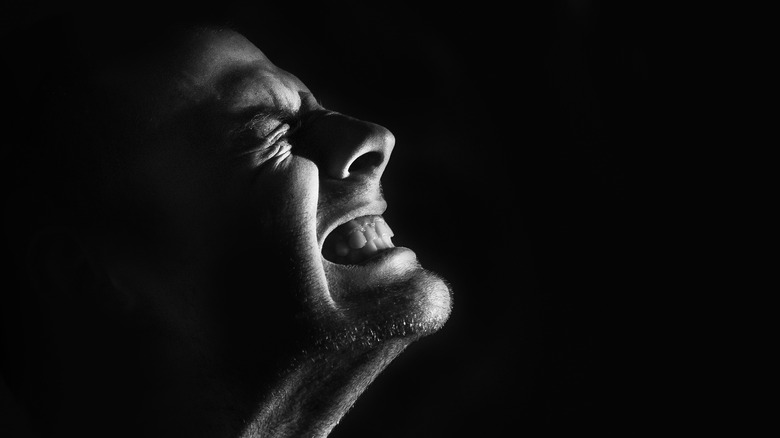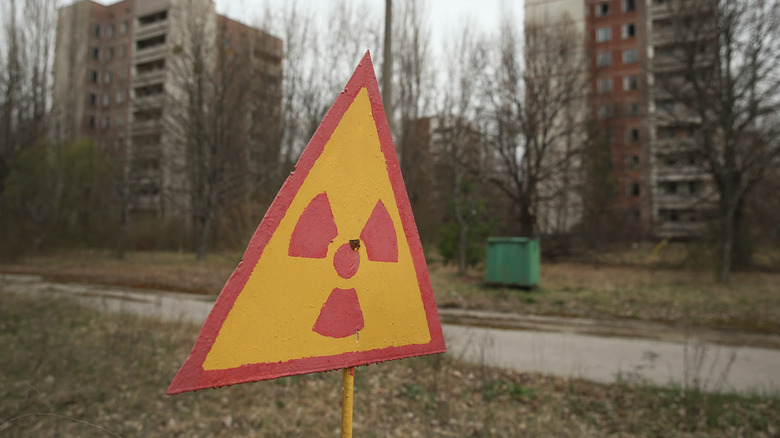The Most Painful Ways To Die, According To Science
No one likes to contemplate death — whether their own or the death of loved ones. It's a natural part of life, and many people have firm beliefs about a next chapter of existence. But the mysterious nature of death makes it a frightening prospect even for people of deep faith. No one who has died can tell us what the experience is like, after all, and people who have supposedly come back from death didn't really die, so their experience may not be reliable.
As noted by The Atlantic, science tells us that most deaths are painless — primarily because we're so out of it by the time we enter what's known as "active dying." And certainly many people who have stood vigil over a dying relative or friend have observed a moment when the person seems to just relax and be at peace right before a rapid decline into death.
But that's a peaceful, slow death, when the body and brain are able to shut down in an orderly fashion. Not all deaths are quite so nice — and some are agonizingly painful. Scientists don't flinch away from the disturbing questions of our existence, so they've done some work in this field. While none of the conclusions are definitive — pain is subjective — there's at least some agreement on what constitutes the worst ways to die. Your mileage may vary, but here are the most painful ways to die according to science.
Crucifixion: The definition of excruciating
It probably shouldn't surprise you that one of the most painful ways to die isn't a natural death at all, but was invented by humans to punish other humans. Most people know about crucifixion from the story of Jesus Christ, but according to Britannica the practice existed long before Christ's time, dating back to about the sixth century BC.
Christ on the cross is one of the most famous examples of crucifixion, however, and many artists choose to depict Christ in a beatific, peaceful manner. There are only four relatively small wounds involved, after all, and while hanging on a cross for hours doesn't seem pleasant, it also may not seem particularly painful — but it is. It's so painful, in fact, that, as noted by Azusa Pacific University, the word "excruciating" actually derives from "crucifixion."
Forbes notes that most depictions of crucifixion get the details wrong. The nails don't go through the palms, but through the wrists, which would feel like "lightning going through your middle and ring fingers" while hitting the median nerve, making your hands contract in agony. A similar strategy is employed on the feet, with the end result that breathing becomes difficult and painful. And while this torture is going on, insects may be gnawing away at the wounds, causing even more pain.
Drowning: More painful than you think
While most people accept that drowning is a terrible way to die, they may assume it's a relatively painless way to go. After all, many people who are drowning don't actually appear to be in distress, according to Slate. And even when people are screaming for help and floundering, it seems more exhausting than painful. And when you finally sink under the waves, it may be assumed that you just pass out.
But drowning can be quite painful. According to Medical Daily, when we're struggling in water, we tend to hyperventilate. This usually leads to breathing in water, which causes a laryngospasm or vocal cord spasm. According to Healthline, breathing in water can be very painful, and if you get water into your lungs the sensation is a searing pain that often lasts long after you're out of the water.
According to an article in The Medico-Legal Journal, this process can be incredibly painful, especially when combined with the sheer panic most people experience while actively drowning. And, as noted by author Sebastian Junger in his book "The Perfect Storm," running out of air and being unable to breathe is "agony."
The only good news is that once you've been starved of oxygen long enough, you'll pass out, and the rest of the drowning process will be pretty peaceful as a result.
Lethal injection: Not so humane
Lethal injection is supposed to be more humane than other forms of execution. As explained by Britannica, in theory this is true: Lethal injection originally included three distinct components — a barbiturate and anesthetic to render the victim unconscious and numb their pain, a muscle relaxant that would paralyze them, and a drug to cause irreversible cardiac arrest. If everything goes perfectly, a lethal injection should render a condemned person dead in five minutes with a minimum of pain.
Unfortunately, that's not the case. After years of legal challenges, most states have abandoned the three-drug protocol in favor of using single drugs, most of which have never been studied or tested. According to The New York Times, even when lethal injection protocols are followed perfectly they can often result in "14 minutes of pain and horror." The Equal Justice Initiative reports it can sometimes be more like two hours, and NPR reports that lethal injection causes agony and a sensation very similar to drowning, with all the panic and terror. Autopsies of executed prisoners have found their lungs filled with fluid and blood — an extreme pulmonary edema. The pain caused by this condition is described as "severe."
Worst of all, many of the drugs used in lethal injection are not anesthetics — they induce sleepiness, but don't do anything to stop pain. Witnesses to executions have described the condemned exhibiting signs of agony.
Electrocution: A gruesome death
As you might imagine, death by electrocution isn't fun — in fact, it's incredibly painful. This has been clearly documented by witnessing what happens when prisoners are put to death in the electric chair.
According to the Death Penalty Information Center, it is horrific. The voltage coursing through the body often causes muscles to seize, which can result in broken bones and fractures. Tissues swell up painfully, and skin can turn bright red and often cracks open as the swelling gets worse. In addition, eyeballs can literally pop out of their sockets, and people often literally catch fire — one man had flames shooting out of his head when he was electrocuted in Florida in 1997, according to The Los Angeles Times.
And you don't need a professional execution to experience agony from electrocution. Health reports that one survivor of an accidental electrocution experienced what they described as "excruciating pain" that required some heavy-duty pain meds. And the National Center for Biotechnology Information Bookshelf notes that many people who are electrocuted suffer cardiac injuries which result in severe chest pain.
The bottom line is that being electrocuted — whether by the state or Mother Nature — can be an excruciatingly painful way to die.
Sudden decompression: An explosively painful death
Most of us will never experience dangerous levels of atmospheric pressure because we wisely stay away from deep water. Which is why most of us are unaware of how excruciatingly painful dying of decompression sickness can be.
As explained by Merck Manuals, decompression sickness occurs because at low depths require divers to breathe compressed air that contains many more molecules of oxygen and nitrogen than on the surface. Which is fine as long as you remain under pressure. The extra oxygen gets used, but the extra nitrogen accumulates. If you rise to lower pressures too fast, the nitrogen expands and forms bubbles, which then cause agonizing pain, damage to tissues and muscles, and even death. As noted by The Guardian, decompression sickness is also commonly known as the bends. One survivor of the experience described how "each gulp of oxygen was torture" — and that's someone who survived.
How painful is decompression? The Byford Dolphin Accident offers a clue. As explained by IFLScience, the Byford Dolphin was a submersible drilling rig owned by BP in 1983. Several divers went very deep, and when they returned to the surface the pressure inside the diving bell was nine times that of the surface. Something went wrong and there was an explosive decompression. The divers literally exploded as the pressurized gas in their bloodstream suddenly expanded. One was "completely disintegrated."
Burning: Extra points for pyroclastic flow
No one's surprised to see "burning to death" on a list of the most painful deaths. If you've ever received even a small burn, it's horrific to imagine that sensation multiplied over your entire body.
According to Valerie Rao, M.D., in her article "Forensic Pathology of Thermal Injuries," people who burn to death see their skin turn black and then split open to expose the tissue beneath to the flames. They may choke on smoke and soot, and their muscles seize up painfully. It's often even painful to breathe because of the superheated air around them. According to The Guardian, the pain is most intense when the flames first burn the skin, and then subsides when the nerves have basically been burned away. But then the flames spread to the next area of skin to begin the process over again.
And that's just simple burning. For an even more intensely agonizing way to die, get caught in a pyroclastic flow — aka, lava. According to IFLScience, lava flows can attain temperatures of 1,830 degrees Fahrenheit. Getting caught in it might seem like an instantaneous death — but that instant would be agonizing. Your skin would be instantly cooked through, and your whole body would contract into what's called a "pugilistic pose" as it slammed into instant rigor mortis. Your brain might also boil inside your skull, shattering it in the process.
Radiation sickness: Invisible agony
Radiation is terrifying because it's often deadly but invisible. You can be standing in a room absolutely smothered in deadly radiation and not know until your body starts to break down in agony.
As noted by researcher Lydia Zablotska, M.D., Ph.D. at the University of California, San Francisco, acute radiation syndrome (ARS) involving gamma radiation means high-energy photons penetrate your body and damage both tissue and genetic material. This can result in a cascade of health problems — bone marrow damage and resulting loss of immunity response, damage to the intestines leading to dehydration and infection, and finally the collapse of your circulatory system.
And if that sounds bad enough, according to an article in the scientific journal "Reports of Practical Oncology and Radiotherapy," depending on your level of exposure, the pain and headache you experience can be described as "excruciating." The scariest thing about radiation poisoning is that you don't have to be involved with a Cherbnobyl-style accident to experience this level of suffering. As noted by The New York Times, in 2007 a man was accidentally exposed to "errant beams of radiation" while undergoing treatment for tongue cancer. He suffered deafness, blindness, the loss of his teeth and ability to swallow, ulcers in his mouth and throat, and what was described as "severe pain." There's little doubt that radiation sickness is one of the most painful ways to go.
Pancreatic cancer: The most painful cancer
All cancers can cause pain. According to The American Cancer Society, cancer can cause pain due to spinal cord compression (when a tumor presses on the nerves in your back), damage done to your bones, and from side effects of surgery and radiation treatments. And according to Practical Pain Management, cancer can also inflict excruciating pain on its victims by directly attacking the nerve cells in your body.
While any cancer can become agonizing as it advances, MedicineNet notes that pancreatic cancer is not just one of the deadliest cancers, it's also often the most painful. This is because it aggressively invades or pushed up against the nerves near the pancreas. This leads to severe abdominal and back pain, and can lead to intestinal blockages that increase the suffering.
According to Healthline, pancreatic cancer is also very difficult to diagnose, and about 80% of tumors aren't detected until the disease is advanced enough to start causing agonizing pain. And Pancreatic Cancer UK notes that pancreatic cancer can also cause soft-tissue pain (also called visceral pain, which is not encouraging). This is a deep-seated aching or cramping that can be difficult to pinpoint, especially because it can cause pain in a distant part of the body, known as referred pain.
Heart Attack: Silent and surprisingly painful
Heart attack is one of the most familiar causes of death in the modern world. It's been depicted in films and televisions shows so often everyone is familiar with it, and the idea of suddenly keeling over is terrifying. While some heart attacks are relatively painless — and thus difficult for people to recognize — a heart attack can be an incredibly painful way to die. Worse, even the warning signs of a heart attack can be pretty painful to experience.
In fact, one of the most common words associated with heart attacks is "excruciating." As noted by Healthline, almost all the warnings that you're about to have a heart attack involve severe pain — chest pain, of course, often described as the sensation of incredible pressure as if an elephant was sitting on your chest, according to The American Heart Association. You can also experience painful symptoms in your chest that feel like heartburn.
Other symptoms include pain in arms, the upper back, shoulders, or the jaw. WebMD describes a woman who woke up with pain shooting down her left arm that she described as "excruciating."
Freezing: Not so peaceful
The popular conception of freezing to death tends to be a dark sort of peace — kind of like falling asleep. But as noted by Transport Canada, that drowsy sense of drifting away is the second stage of hypothermia that usually occurs right before losing consciousness. According to HowStuffWorks, freezing to death is a process, starting with uncontrollable shivering as your body attempts to generate heat, then moving to muscle stiffness and disorientation as your heat-starved body begins to malfunction.
And those malfunctions can be agonizing. As explained by Outside Online, when your core body temperature drops ,your body will pull circulating blood from your extremities to keep your vital organs warmer, resulting in excruciating aching in your hands and feet. Frostbite can develop, inflicting even more suffering on your body as its initial stages are often accompanied by a burning sensation, according to WebMD — though if it worsens, you'll soon lose all feeling in the affected areas.
After that, it's true that you'll feel less and less pain as your body numbs and your brain starts to misfire, plunging you into a confusion that can lead to what scientists call paradoxic undressing, which Live Science explains is when people suffering severe hypothermia actually take off their clothes. They also often attempt to burrow into the freezing ground while naked.
Exposure to chlorine trifluoride
If you've ever wondered if the universe hates you, the mere existence of a substance like chlorine trifluoride (ClF3) should prove it to you. As noted by Discovery, ClF3 was isolated back in the 1930s when scientists were looking for something that was just as reactive as fluoride but easier to store. And ClF3 sure is a reactive liquid — it's so reactive it will pretty much set anything it touches on fire on contact.
In his book "Ignition! An Informal History of Liquid Rocket Propellants," author John Drury Clark recounts an instance when a metal cylinder of ClF3 broke open, spilling a ton of the stuff onto a facility's floor, writing "it chewed its way through twelve inches of concrete and dug a three-foot hole in the gravel underneath [and] filled the place with fumes which corroded everything in sight." The entire area had to be evacuated.
Contact with ClF3 is easily one of the most painful and horrifying ways to go. According to The National Library of Medicine, even "mild to moderate" exposure to ClF3 causes "severe pain," while a severe exposure produces "rapid pain," including "painful necrotic lesions." All that pain makes sense once you know what this stuff does to the human body. As scientist Paul Doherty told Live Science, "the chlorine will turn your bones to gelatin — your fingers will turn from rods into little rounded stubs." It's so dangerous the compound has been banned around the world for decades.
Boomslang: The absolute worst
The word "boomslang" might sound like something out of a sci-fi novel, but as explained by Discover Magazine a boomslang is actually a species of snake, a member of the Colubridae or rear-fanged snake family. It also sports one of the most fatal venoms a human can encounter. As noted by Britannica, boomslang venom causes hemorrhages, and even a tiny amount of it can kill you.
Worst of all, death by boomslang is one of the most painful ways you can die. IFLScience reports that the venom causes your body to create a lot of tiny blood clots, which makes it impossible to clot when you need it, resulting in both internal bleeding and bleeding from the orifices, along with severe fever, nausea, and uncontrollable shaking.
According to Natural History Museum, when researcher Karl P. Schmidt was bitten by a boomslang in 1957, he didn't seek treatment immediately, choosing instead to keep a diary of his experience. The diary is tough reading, because Schmidt experienced agonizing pain as he bled from his gums, eyes, and mouth, urinated blood, and vomited blood and anything else in his stomach.
Luckily for you, your chances of encountering a boomslang are relativity small unless you're in sub-Saharan Africa, according to the South African National Biodiversity Institute, in which case you'd better learn how to identify one.












